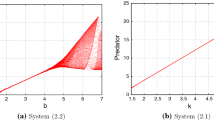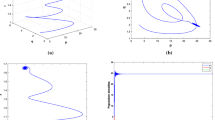Abstract
In the present work, we explore the influence of habitat complexity on the activities of prey and predator of a spatio-temporal system by incorporating self-diffusion. First, we modify the Rosenzweig–MacArthur predator–prey model by incorporating the effects of habitat complexity on the carrying capacity and fear effect of prey and predator functional response. We establish conditions for the existence and stability of all feasible equilibrium points of the non-spatial model, and later we prove the existence of Hopf and transcritical bifurcations in different parametric phase-planes analytically and numerically. The stability of the spatial system is studied, and we discuss the conditions for Turing instability. Selecting suitable control parameter from the Turing space, the existence conditions for stable patterns are derived using the amplitude equations. Results obtained from theoretical analysis of the amplitude equations are justified by numerical simulation results near the critical parameter value. Further, from numerical simulation, we illustrate the effect of diffusion of the dynamical system in the spatial domain by different pattern formations. Thus, our model clearly shows that the fear effect of prey and predator’s functional response makes an anti-predator behaviour including habitat complexity which helps the prey to survive in the spatio-temporal domain through diffusive process.

















Similar content being viewed by others
References
D. Alstad, Basic Populas Models of Ecology (Prentice Hall Inc, Prentice, 2001)
T.W. Anderson, Predator responses prey refuges and density-dependent mortality of a marine fish. Ecology 82, 245–257 (2001)
R.A. Armstrong, R. McGehee, Competitive exclusion. Am. Nat. 115, 151–170 (1980)
M. Banerjee, S. Abbas, Existence and non-existence of spatial patterns in a ratio-dependent predator–prey model. Ecol. Complex 21, 199–214 (2015)
M. Banerjee, S. Banerjee, Turing instabilities and spatio-temporal chaos in ratio-dependent Holling–Tanner model. Math. Biosci. 236, 64–76 (2012)
M. Banarjee, S. Petrovskii, Self-organized spatial pattern and chaos in a ratio dependent predator–prey system. Theor. Ecol. 4, 37–53 (2011)
B. Bozzini, G. Gambino, D. Lacitignola, S. Lupo, M. Sammartino, I. Sgura, Weakly nonlinear analysis of Turing patterns in a morphochemical model for metal growth. Comput. Math. Appl. 70, 1948–1969 (2015)
S.S. Bell, Habitat complexity of polychaete tube caps: influence of architecture on dynamics of a meioepibenthic assemblage. J. Mar. Res. 43, 647–657 (1985)
S. Bell, E. McCoy, H. Mushinsky, Habitat Structure: The Physical Arrangement of Objects in Space (Chapman & Hall, London, 1991), pp. 3–27
T.A. Burton, Volterra Integral and Differential Equations (Academic Press Inc, Orlando, 1983)
J.B. Collings, Bifurcation and stability analysis of temperature-dependent mite predator–prey interaction model incorporating a prey refuge. Bull. Math. Biol. 57, 63–76 (1995)
B.C. Coull, J.B.J. Wells, Refuges from fish predation: experiments with phytal meiofauna from the New Zealand rocky intertidal. Ecology 64, 1599–1609 (1983)
S. Creel, D. Christianson, Relationships between direct predation and risk effects. TREE 23, 194–201 (2008)
W. Cresswell, Predation in bird populations. J. Ornithol. 152(1), 251–263 (2011)
V. Dufiet, J. Boissonade, Dynamics of turing pattern monolayers close to onset. Phys. Rev. E 53(5), 4883–4892 (1996)
H.I. Freedman, Deterministic Mathematical Method in Population Ecology (Marcel Debber, New York, 1980)
W.J. Freeland, D. Choquenot, Determinants of herbivore carrying capacity: plants, nutrients, and Equus Asinus in Northern Australia. Ecology 71, 589–597 (1990)
S. Ghorai, S. Poria, Emergent impacts of quadratic mortality on pattern formation in a predator–prey system. Nonlinear Dyn. 87, 2715–2734 (2017)
O.E. Gonzalez, J.R. Ramos, Dynamics consequences of prey refuge in a simple model system: more prey and few predators and enhanced stability. Ecol. Model. 166, 135–146 (2003)
M.A. Hixon, B.A. Menge, Species diversity: prey refuges modify the interactive effects of predation and competition. Theor. Popul. Biol. 39(2), 178–200 (1991)
M.E. Hochberg, R.D. Holt, Refuge evolution and the population dynamics of coupled of host–parasitoid associations. Evolut. Ecol. 9, 633–661 (1995)
R.D. Holt, Prey communities in patchy environment. OIKOS 50, 276–290 (1987)
Y. Huang, F. Chen, L. Zhong, Stability analysis of prey–predator model with Holling type-III response function incorporating a prey refuge. Appl. Math. Comput. 182, 672–683 (2006)
N.E. Humphries, H. Weimerskirchc, N. Queiroza, E.J. Southalla, D.W. Simsa, Foraging success of biological Levy flights recorded in situ. Proc. Natl. Acad. Sci. 109, 7169–7174 (2011)
M. Ipsen, F. Hynne, P.G. Sorensen, Amplitude equations for reaction–diffusion systems with a Hopf bifurcation and slow real modes. Physica D 136, 66 (2000)
P.L. James, K.L. Heck Jr., The effects of habitat complexity and light intensity on ambush predation within a simulated seagrass habitat. J. Exp. Mar. Biol. Ecol. 176, 187–200 (1994)
D. Jana, R. Agrawal, R.K. Upadhyay, Dynamics of generalist predator in a stochastic environment: effect of delayed growth and prey refuge. Appl. Math. Comput. 268, 1072–1094 (2015)
D. Jana, N. Bairagi, Habitat complexity, dispersal and metapopulations: macroscopic study of a predator–prey system. Ecol. Complex. 17, 131–139 (2014)
D. Jana, S. Ray, Impact of physical and behavioral prey refuge on the stability and bifurcation of Gause type Filippov prey–predator system. Model. Earth Syst. Environ. 2, 24 (2016)
W.D. Johnson, Predation, habitat complexity and variation in density dependent mortality of temperate reef fishes. Ecology 87, 1179–1188 (2006)
T.K. Kar, Stability analysis of a prey predator model incorporating a prey refuge. Commun. Nonlinear Sci. Numer. Simul. 10, 681–691 (2005)
V. Krivan, Effect of optimal antipredator behaviour of prey on predator–prey dynamics: the role of refuge. Theor. Popul. Biol. 53, 131–142 (1998)
V. Krivan, On the Gause predator–prey model with a refuge: a fresh look at the history. J. Theor. Biol. 274, 67–73 (2011)
M. Lakshmanan, S. Rajasekar, Nonlinear Dynamics: Integrability, Chaos and Patterns (Springer, New York, 2003)
S.A. Lassau, D.F. Hochuli, Effects of habitat complexity on ant assemblages. Ecography 27, 157–164 (2004)
S.L. Lima, Nonlethal effects in the ecology of predator–prey interactions. Bioscience 48(1), 25–34 (1998)
S.L. Lima, Predators and the breeding bird: behavioral and reproductive flexibility under the risk of predation. Biol. Rev. 84(3), 485–513 (2010)
R.M. May, Stability and Complexity in Model Ecosystem (Princeton University Press, Princeton, 1974)
J.R. McAuliffe, Competition for space, disturbance, and the structure of a benthic stream community. Ecology 65, 894–908 (1984)
J.N. McNair, The effect of refuge on prey–predator interactions: a reconsideration. Theor. Popul. Biol. 29, 38–63 (1986)
J.D. Meiss, Differential Dynamical Systems (Society for Industrial and Applied Mathematics, Philadelphia, 2007)
H. Merdan, S. Kayan, Hopf bifurcations in Lengyel epstein reaction diffusion model with discrete time delay. Nonlinear Dyn. 79, 1757–1770 (2015)
P. Meyer, J. Ausubel, Carrying capacity: a model with logistically varying limits. Technol. Forecast. Soc. Change 61, 209–214 (1999)
G.T. Miller, S.E. Spoolman, Each species plays a unique role in its ecosystem, in Essentials of Ecology. Belmont: Cengage Learning, 91 (2009)
J.L. Orrock, E.L. Preisser, J.H. Grabowski, G.C. Trussell, The cost of safety: Refuges increase the impact of predation risk in aquatic systems. Ecology 94(3), 573–579 (2013)
G.D. Ruxton, Short term refuge use and stability of predator–prey model. Theor. Popul. Biol. 47, 1–17 (1995)
S. Sarwardi, P.K. Mandal, S. Ray, Analysis of a competitive prey–predator system with a prey refuge. BioSystems 110, 133–148 (2012)
S. Sasmal, Population dynamics with multiple Allee effects induced by fear factors induced by fear factors—a mathematical study on prey–predator. Appl. Math. Model. 64, 1–14 (2018)
L.A. Segel, L.A. Jackson, Dissipative structure: an explanation and an ecological example. J. Theor Biol. 37, 545–559 (1972)
A. Sih, Prey refuges and predator–prey stability. Theor. Popul. Biol. 31, 1–12 (1987)
G.Q. Sun, A. Chakraborty, Q.X. Liu, Z. Jin, K.E. Anderson, B.L. Li, Influence of time delay and nonlinear diffusion on herbivore outbreak. Commun. Nonlinear Sci. Numer. Simulat. 19, 1507–1518 (2014)
G.Q. Sun, Z. Jin, Q. Liu, L. Li, Pattern formation inducedby cross-diffusion in a predator–prey system. Chin. Phys. B 17(11), 3936–3941 (2008)
R.I. Taylor, Predation (Chapman and Hall, New York, 1984)
A.M. Turing, The chemical basis of mokphogenesis. Philos. Trans. R. Soc. Lond. 237, 37–72 (1952)
R.K. Upadhyay, S. Mishra, Population dynamic consequences of fearful prey in a spatiotemporal predator–prey system. Math. Biosci. Eng. 16(1), 338–372 (2018)
R.K. Upadhyay, V. Volpert, N.K. Thakur, Propagation of turing patterns in plankton model. J. Biol. Dyn. 6, 524–538 (2012)
Y. Wang, J. Cao, G.Q. Sun, J. Li, Effect of time delay on pattern dynamics in a spatial epidemic model. Physica A 412, 137–148 (2014)
W. Wang, Y. Li, F. Rao, L. Zhang, Y. Tan, Pattern selection in a ratio-dependent predator–prey model. J. Stat. Mech. Theory Exp. (2010). https://doi.org/10.1088/1742-5468/2010/11/P11036
W. Wang, Q.X. Liu, Z. Jin, Spatiotemporal complexity of a ratio-dependent predator–prey system. Phys. Rev. E 75(5), 051913 (2007)
W. Wang, W. Wang, Y. Lin, Y. Tan, Pattern selection in a predation model with self and cross diffusion. Chin. Phys. B (2011). https://doi.org/10.1088/1674-1056/20/3/034702
W. Wang, L. Zhang, H. Wang, Z. Li, Pattern formation of a predator–prey system with Ivlev-type functional response. Ecol. Model. 221(2), 131–140 (2010)
X. Wang, L. Zanette, X. Zou, Modelling the fear effect in predator–prey interactions. J. Math. Biol. 73(5), 1–26 (2016)
X. Wang, X. Zou, Modeling the fear effect in predator–prey interactions with adaptive avoidance of predators. Bull. Math. Biol. 79(6), 1–35 (2017)
L. Xue, Pattern formation in a predator–prey model with spatial effect. Physica A 391, 5987–5996 (2012)
X.P. Yan, C.H. Zhang, Stability and turing instability in a diffusive predator–prey system with Beddington–Deangelis functional response. Nonlinear Anal. RWA 20, 1–13 (2014)
S. Yuan, C. Xu, T. Zhang, Spatial dynamics in a predator–prey model with herd behavior. Chaos 23(3), 033102 (2013)
L.Y. Zanette, M. Clinchy, Perceived predation risk reduces the number of offspring songbirds produce per year. Science 334(6061), 1398–1401 (2011)
G. Zhang, W. Wang, X. Wang, Coexistence states for a diffusive one-prey and two-predators with b–d functional response. Comput. Math. Appl. 387, 931–948 (2012)
J. Zhang, W. Li, X. Yan, Hopf bifurcation and Turing instability in spatial homogeneous and inhomogeneous predator–prey models. Appl. Math. Comput. 218(5), 1883–1893 (2011)
T. Zhang, Y. Xing, H. Zang, M. Han, Spatio-temporal dynamics of a reaction–diffusion system for a predator–prey model with hyperbolic mortality. Nonlinear Dyn. 78(1), 265–277 (2014)
X.C. Zhang, G.Q. Sun, Z. Jin, Spatial dynamics in a predator–prey model with Beddington–Deangelis functional response. Phys. Rev. E 85, 021924 (2012)
W. Zuo, Y. Song, Stability and bifurcation analysis of a reaction diffusion equation with distributed delay. Nonlinear Dyn. 79, 437–454 (2015)
Funding
Research of M.L. is supported by DST-SERB by a Distinguished Fellowship and research of Debaldev Jana is supported by SERB, Govt. of India fund (MTR/2019/000788).
Author information
Authors and Affiliations
Corresponding author
Ethics declarations
Conflict of interest
The authors declare that they have no conflict of interest.
Rights and permissions
About this article
Cite this article
Jana, D., Batabyal, S. & Lakshmanan, M. Self-diffusion-driven pattern formation in prey–predator system with complex habitat under fear effect. Eur. Phys. J. Plus 135, 884 (2020). https://doi.org/10.1140/epjp/s13360-020-00897-5
Received:
Accepted:
Published:
DOI: https://doi.org/10.1140/epjp/s13360-020-00897-5




